Cement-Based Mortars with Waste Paper Sludge-Derived Cellulose Fibers for Building Applications
Abstract
1. Introduction
2. Experimental Preparation
2.1. Waste Paper Sludge
2.2. Materials and Methods
2.2.1. Mortar Specimens
2.2.2. Masonry Walls
3. Results
3.1. Compressive and Flexural Properties of Mortars
3.2. Compressive Response of Small-Scale Masonry Walls
4. Conclusions
- Increasing the percentage of cellulose fibers in the mortar altered the post-crack behavior of the specimens. The traditional mortars (0% cellulose fibers) exhibited a sudden load decrease in strength at the end of the test, whereas the mortars containing 1% and 2% of cellulose fibers continued to deform after reaching the peak load. This behavior can be associated with the energy absorbed by the fibers and the capacity of the fibers to transfer tensile stresses between the two faces of the cracks, which improves the deformation capacity of the material.
- The cement-based mortar specimens made following an accurate preparation protocol (CM-I-1 and CM-I-2) exhibited relatively low variations in the flexural tensile strength compared to the traditional mortars (less than 5% of relative differences). This suggests a uniform fiber dispersion in the material. However, the compressive strength decreased by approximately 10%. This result is mainly attributed to the increased porosity of the material.
- The cement-based mortar specimens (CM-II-1 and CM-II-2) made without rigorous control of the preparation parameters presented a higher flexural tensile strength (compared to traditional mortar) when the fiber content was increased from 0% to 1%; this is mainly due to the fiber bridging effect. However, at 2% of fiber content, significant reductions occurred, likely due to non-uniform fiber dispersion. Concerning the compressive strength, a non-monotonic trend was observed with an increase in the percentage of the fiber content, with the CM-II-2 specimens showing reductions of 30% compared to the TM-II-0 specimens.
- Changes in the mortar’s compressive strength did not significantly affect the load-bearing capacity of the masonry walls. The eco-friendly mortar slightly increased the wall’s compressive strength (<10%) compared to the traditional mortar, primarily due to the higher compressive strength of the former. In general, the cellulose fibers did not significantly affect the masonry’s compressive behavior, which was mainly influenced by the brick’s compressive strength.
- The formula provided by EN 1996-1-1:2022 [29] resulted in non-accurate predictions of the compressive strength for masonry walls prepared using traditional and eco-friendly mortars. On the other hand, more accurate estimates were obtained when using the values given by the Italian code [28] and the relationship proposed by the authors. Concerning the elastic modulus predictions, both EN 1996-1-1:2022 [29] and the Italian code [28] overestimated the experimental results, regardless of the type of mortar used.
- Experimental investigations are needed to define optimal cellulose fiber content that exploits both mechanical strength and durability while minimizing material costs.
- Microstructural analyses (SEM or computed tomography) should be performed to obtain a further understanding of the “macroscopic” behavior of the mortars incorporating cellulose fibers.
- More in-depth studies should focus on the environmental impact of these eco-friendly mortars, including life cycle assessments (LCA), with the aim of providing a better understanding of the sustainability benefits and drawbacks of these materials compared to traditional options.
- Experimental studies about the long-term durability of eco-friendly mortars are needed, including exposure to harsh environmental conditions and aging effects, with the aim of providing insights into structural performance and stability over extended service lifetimes.
Author Contributions
Funding
Data Availability Statement
Acknowledgments
Conflicts of Interest
References
- Lima, L.; Trindade, E.; Alencar, L.; Alencar, M.; Silva, L. Sustainability in the Construction Industry: A Systematic Review of the Literature. J. Clean. Prod. 2021, 289, 125730. [Google Scholar] [CrossRef]
- Nilimaa, J. Smart Materials and Technologies for Sustainable Concrete Construction. Dev. Built Environ. 2023, 15, 100177. [Google Scholar] [CrossRef]
- Divyah, N.; Rajagopal, T.; Meyappan, N.; Ramaiah, P. Characterization and Behavior of Basalt Fiber-Reinfoced Lightweight Concrete. Struct. Concr. 2020, 22, 422–430. [Google Scholar] [CrossRef]
- Rucińska, T. Sustainable Cement Mortars. E3S Web Conf. 2018, 49, 00090. [Google Scholar] [CrossRef]
- Atiyeh, M.; Aydin, E. Carbon-Fiber Enriched Cement-Based Composites for Better Sustainability. Materials 2020, 13, 1899. [Google Scholar] [CrossRef]
- Todaro, F.; Petrella, A.; Santomasi, G. Environmental Sustainable Cement Mortars Based on Polyethylene Terephthalate from Recycling Operations. Materials 2023, 16, 2111. [Google Scholar] [CrossRef]
- Sanjuán, M.Á.; Andrade, C.; Mora, P.; Zaragoza, A. Carbon Dioxide Uptake by Cement-Based Materials: A Spanish Case Study. Appl. Sci. 2020, 10, 339. [Google Scholar] [CrossRef]
- Costa, F.N.; Ribeiro, D.V. Reduction in CO2 Emissions during Production of Cement, with Partial Replacement of Traditional Raw Materials by Civil Construction Waste (CCW). J. Clean. Prod. 2020, 276, 123302. [Google Scholar] [CrossRef]
- Sekar, K.C.; Murugesan, R.; Sivaraja, M.; Prakash, R. Development of Sustainable Concrete from Hypo Sludge Combined with Basalt Fibre and Latex. Sustainability 2023, 15, 10986. [Google Scholar] [CrossRef]
- Mohamad, N.; Muthusamy, K.; Embong, R.; Kusbiantoro, A.; Hashim, M.H. Environmental Impact of Cement Production and Solutions: A Review. Mater. Today Proc. 2021, 48, 741–746. [Google Scholar] [CrossRef]
- Danish, A.; Ali Mosaberpanah, M.; Usama Salim, M.; Ahmad, N.; Ahmad, F.; Ahmad, A. Reusing Biochar as a Filler or Cement Replacement Material in Cementitious Composites: A Review. Constr. Build. Mater. 2021, 300, 124295. [Google Scholar] [CrossRef]
- Puertas, F.; Vazquez, T. Behaviour of Cement Mortars Containing an Industrial Waste from Aluminium Refining Stability in Ca(OH)2 Solutions. Cem. Concr. Res. 1999, 29, 1673–1680. [Google Scholar] [CrossRef]
- Yang, B.; Jang, J.G. Environmentally Benign Production of One-Part Alkali-Activated Slag with Calcined Oyster Shell as an Activator. Constr. Build. Mater. 2020, 257, 119552. [Google Scholar] [CrossRef]
- Kharola, S.; Ram, M.; Goyal, N.; Mangla, S.K.; Nautiyal, O.P.; Rawat, A.; Kazancoglu, Y.; Pant, D. Barriers to Organic Waste Management in a Circular Economy. J. Clean. Prod. 2022, 362, 132282. [Google Scholar] [CrossRef]
- Fernando, S.; Gunasekara, C.; Shahpasandi, A.; Nguyen, K.; Sofi, M.; Setunge, S.; Mendis, P.; Rahman, M.T. Sustainable Cement Composite Integrating Waste Cellulose Fibre: A Comprehensive Review. Polymers 2023, 15, 520. [Google Scholar] [CrossRef]
- Lee, J.I.; Kim, C.Y.; Yoon, J.H.; Choi, S.J. Mechanical Properties of Cement Mortar Containing Ground Waste Newspaper as Cementitious Material. Materials 2023, 16, 1374. [Google Scholar] [CrossRef]
- Furszyfer Del Rio, D.D.; Sovacool, B.K.; Griffiths, S.; Bazilian, M.; Kim, J.; Foley, A.M.; Rooney, D. Decarbonizing the Pulp and Paper Industry: A Critical and Systematic Review of Sociotechnical Developments and Policy Options. Renew. Sustain. Energy Rev. 2022, 167, 112706. [Google Scholar] [CrossRef]
- Statista Research Department: Global Production of Paper and Paperboard 1961–2021, 29 August 2023. Global Paper and Paperboard Production 2021|Statista. Available online: https://www.statista.com/statistics/240598/production-of-paper-and-card (accessed on 14 November 2023).
- Ardanuy, M.; Claramunt, J.; Toledo Filho, R.D. Cellulosic Fiber Reinforced Cement-Based Composites: A Review of Recent Research. Constr. Build. Mater. 2015, 79, 115–128. [Google Scholar] [CrossRef]
- de Azevedo, A.R.G.; Alexandre, J.; de Xavier, G.C.; Pedroti, L.G. Recycling Paper Industry Effluent Sludge for Use in Mortars: A Sustainability Perspective. J. Clean. Prod. 2018, 192, 335–346. [Google Scholar] [CrossRef]
- Rezende, E.C.L.; Costa e Silva, A.J.; Delgado, J.M.P.Q.; Azevedo, A.C. Technological Performance of Recycled Waste Paper Cellulosic Fibre Reinforced Cement-Based Mortars. J. Build. Pathol. Rehabil. 2021, 6, 43. [Google Scholar] [CrossRef]
- Yan, S.; Sagoe-Crentsil, K.; Shapiro, G. Reuse of De-Inking Sludge from Wastepaper Recycling in Cement Mortar Products. J. Environ. Manag. 2011, 92, 2085–2090. [Google Scholar] [CrossRef] [PubMed]
- Bentchikou, M.; Guidoum, A.; Scrivener, K.; Silhadi, K.; Hanini, S. Effect of Recycled Cellulose Fibres on the Properties of Lightweight Cement Composite Matrix. Constr. Build. Mater. 2012, 34, 451–456. [Google Scholar] [CrossRef]
- Bencardino, F.; Cecchi, A.; Franceschi, M.; Nisticò, M.; Ombres, L.; Verre, S. Structural Behavior of Small-Scale Masonry Panel with Fiber Reinforced Mortar under Compressive Load. Key Eng. Mater. 2019, 817, 472–477. [Google Scholar] [CrossRef]
- EN 1015-11; Methods of Test for Mortar for Masonry—Part 11: Determination of Flexural and Compressive Strength of Hardened Mortar. European Committee for Standardization: Brussels, Belgium, 2019.
- EN 1052-1; Methods of Test for Masonry—Part 1: Determination of Compressive Strength. European Committee for Standardization: Brussels, Belgium, 1998.
- EN 772-1; Methods of Test for Masonry Units—Part 1: Determination of Compressive Strength. European Committee for Standardization: Brussels, Belgium, 2011.
- MIT. Aggiornamento delle«Norme Tecniche per le Costruzioni»; Supplemento ordinario n. 8 alla Gazzetta Ufficiale del 20-2-2018; Ministero delle Infrastrutture e dei Trasporti: Rome, Italy, 2018. (In Italian)
- EN 1996-1-1; Design of Masonry Structures. European Committee for Standardization: Brussels, Belgium, 2022.



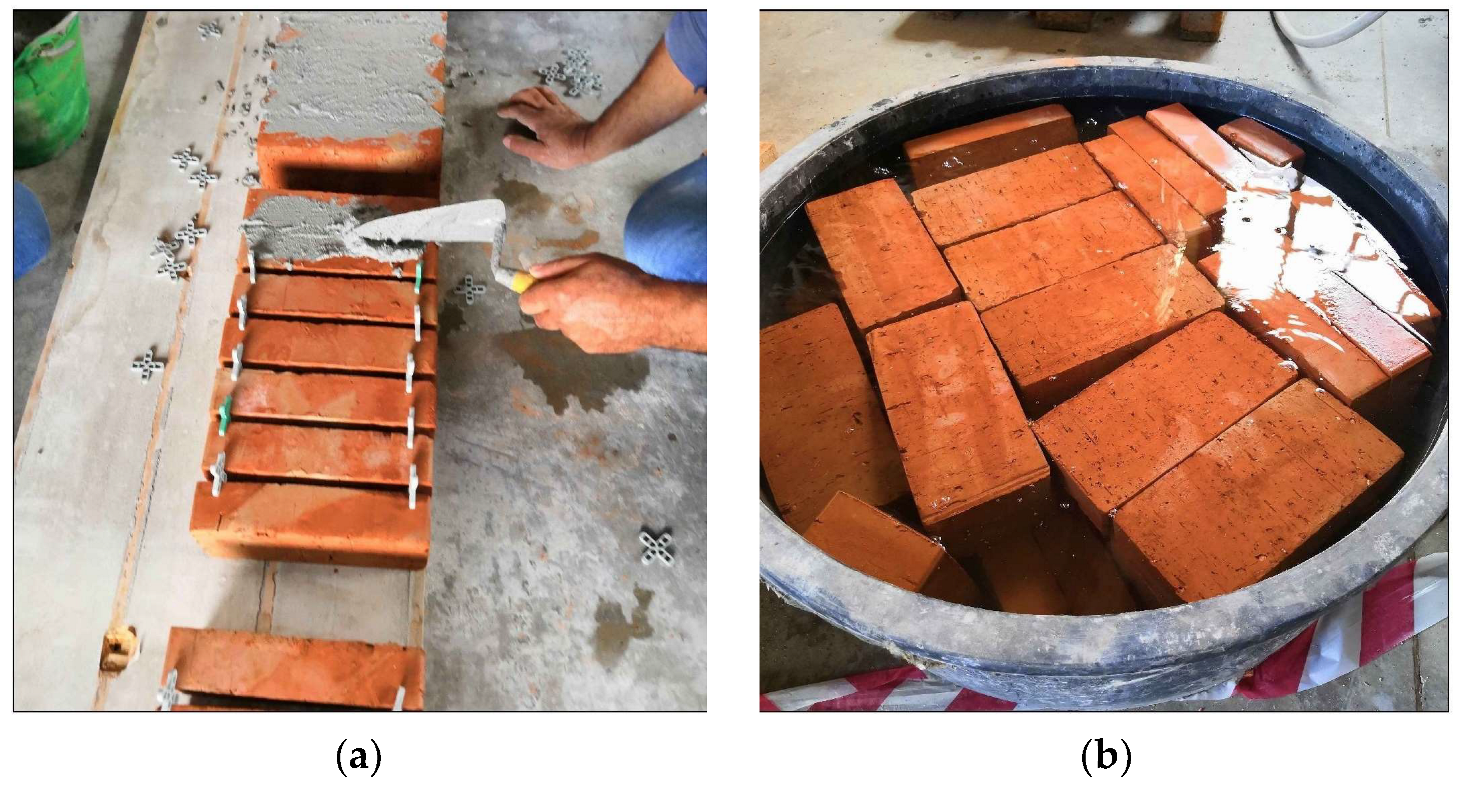

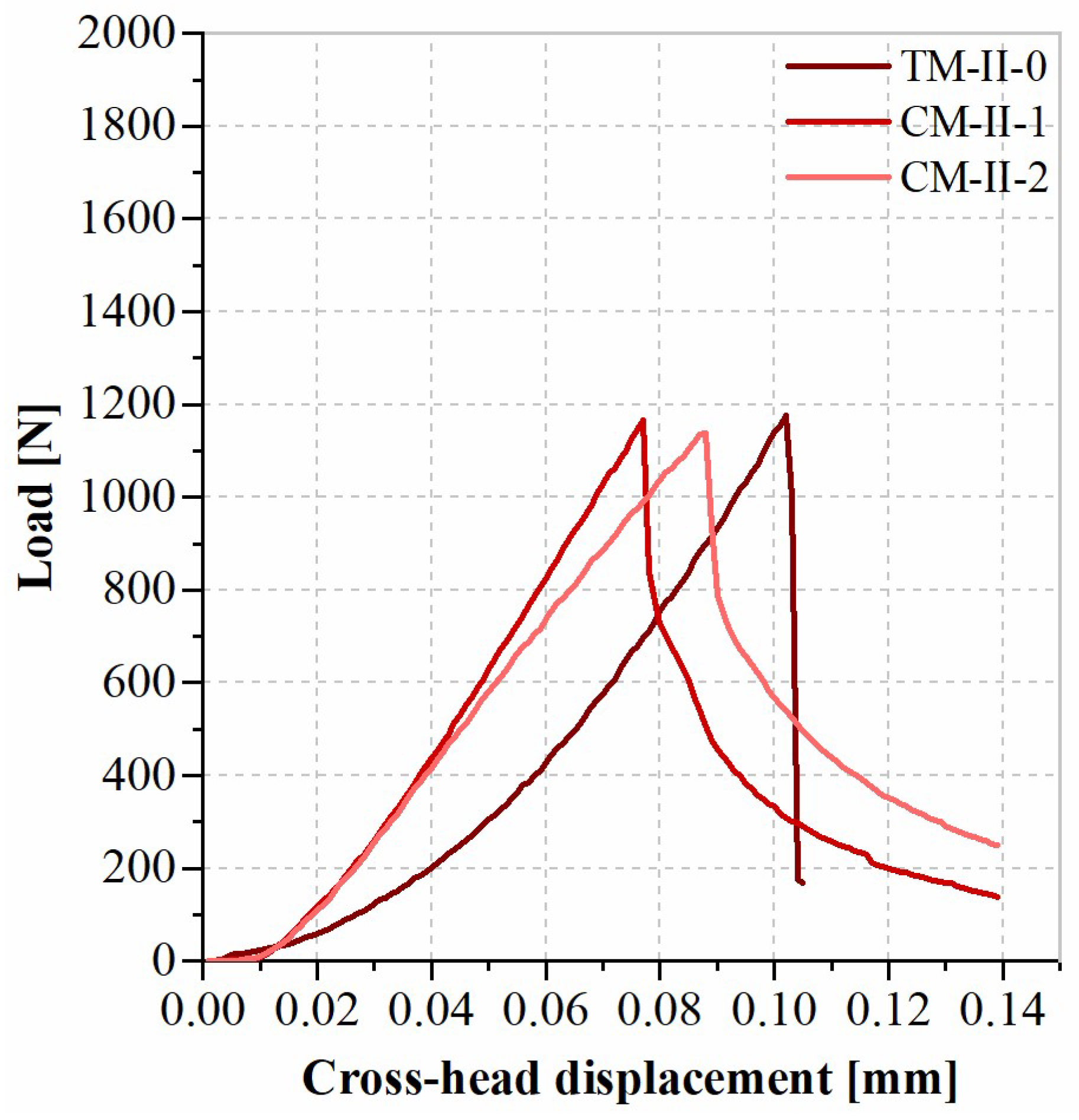
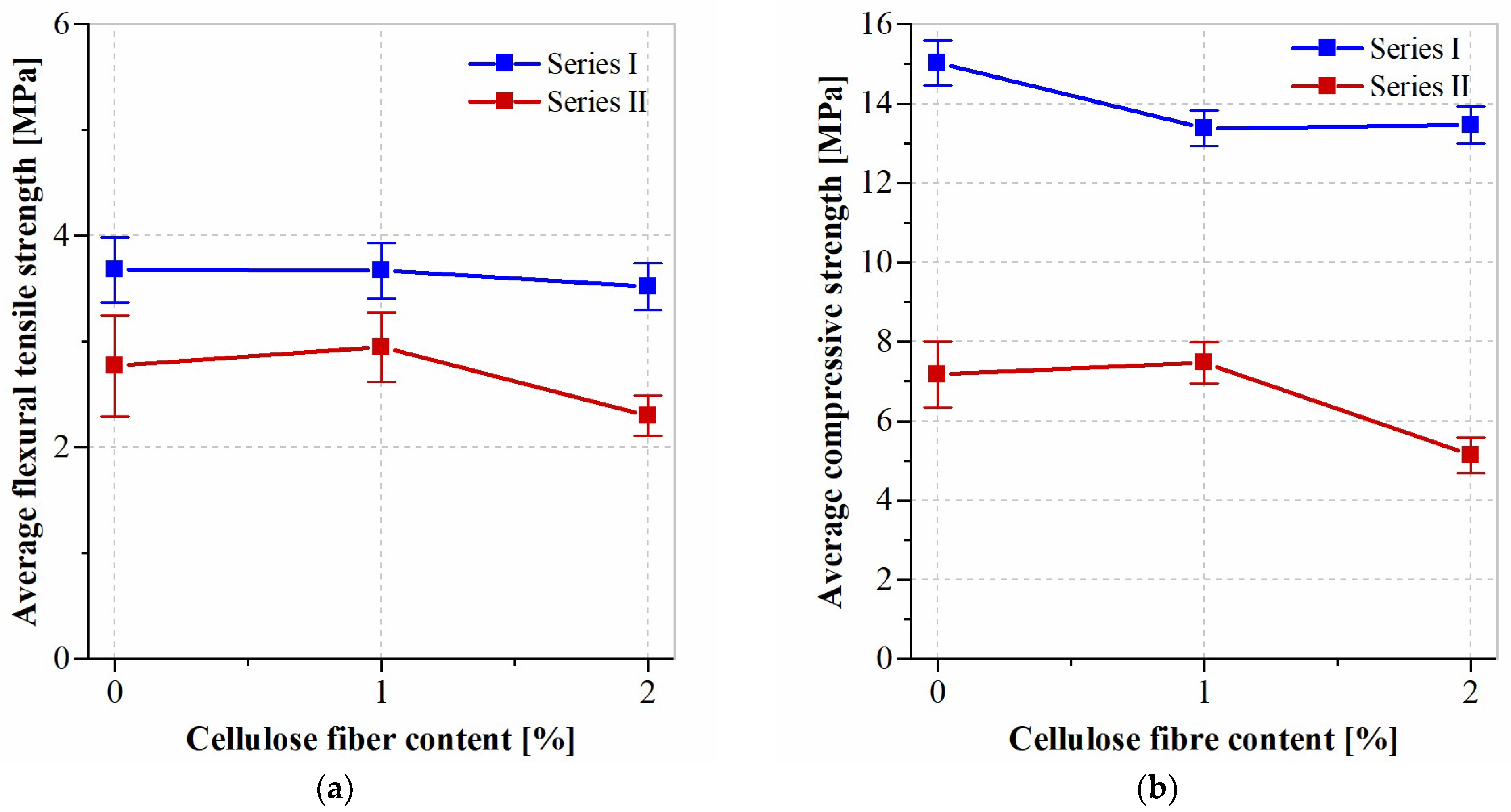
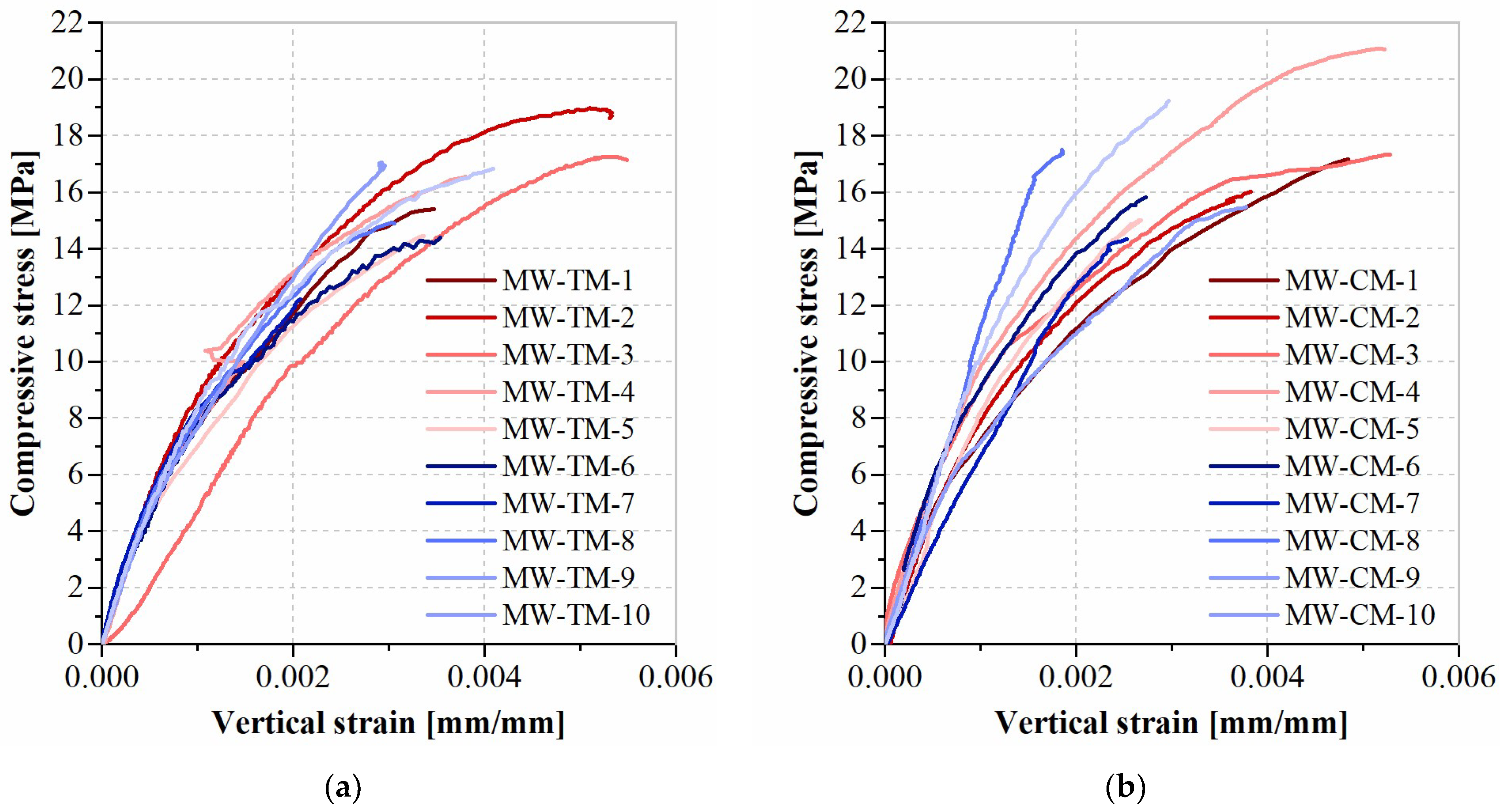
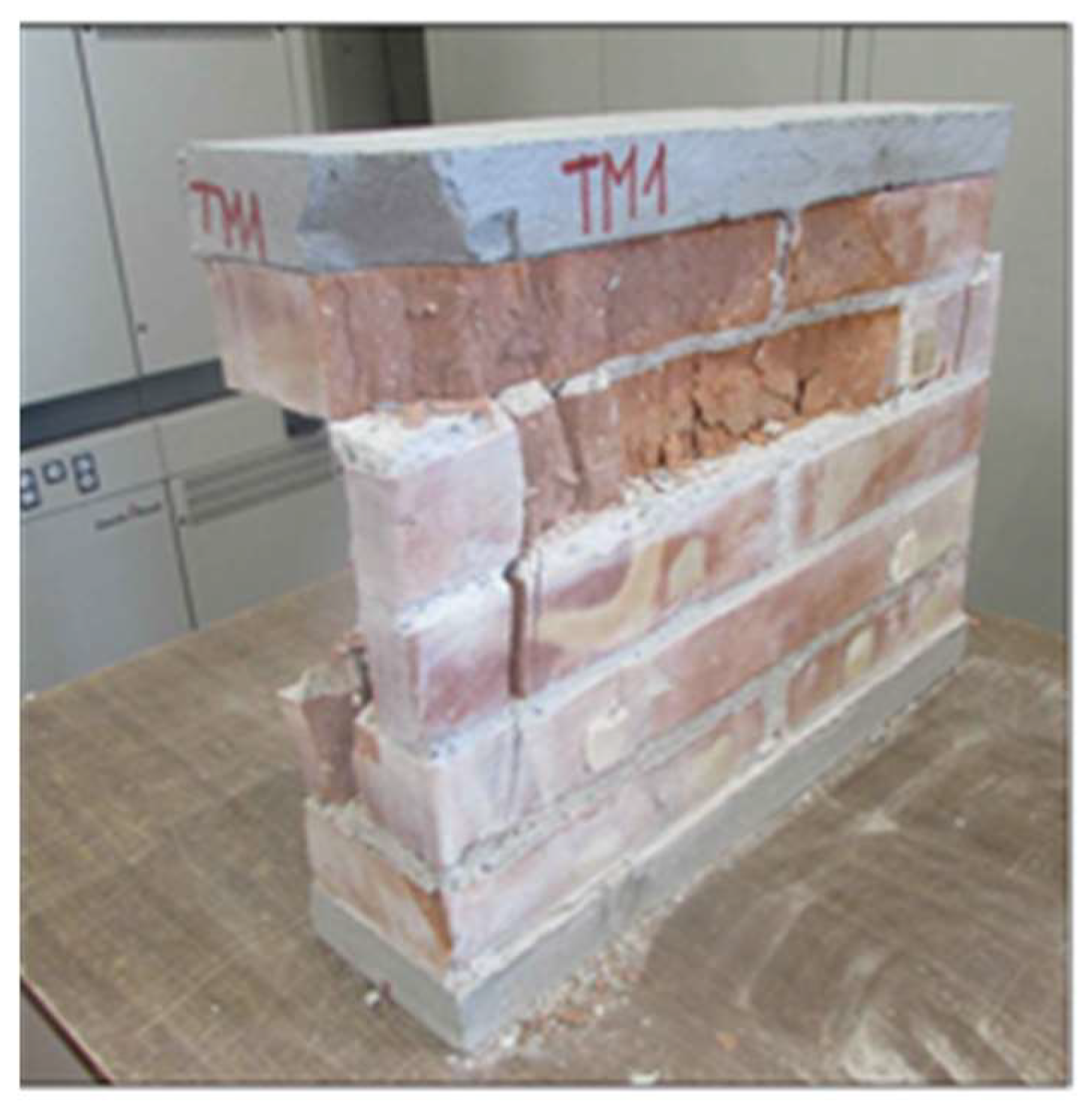
| Mortars | Cement | Lime | Sand | Cellulose Fibers (%) | W/B |
|---|---|---|---|---|---|
| TM-I-0 | 1 | 1 | 5 | 0 | 0.50 |
| CM-I-1 | 1 | 1 | 5 | 1 | 0.53 |
| CM-I-2 | 1 | 1 | 5 | 2 | 0.56 |
| TM-II-0 | 1 | 1 | 5 | 0 | 0.50 |
| CM-II-1 | 1 | 1 | 5 | 1 | N.C. |
| CM-II-2. | 1 | 1 | 5 | 2 | N.C. |
| Mortars | ftm [MPa] | ftm,k [MPa] | fcm [MPa] | fcm,k [MPa] |
|---|---|---|---|---|
| TM-I-0 | 3.68 ± 0.31 | 3.08 | 15.02 ± 0.57 | 15.02 |
| CM-I-1 | 3.67 ± 0.26 | 3.15 | 13.38 ± 0.45 | 13.38 |
| CM-I-2 | 3.52 ± 0.22 | 3.09 | 13.46 ± 0.46 | 13.46 |
| TM-II-0 | 2.77 ± 0.48 | 1.86 | 7.17 ± 0.83 | 5.55 |
| CM-II-1 | 2.95 ± 0.33 | 2.37 | 7.47 ± 0.52 | 6.56 |
| CM-II-2 | 2.30 ± 0.19 | 1.95 | 5.14 ± 0.45 | 4.23 |
| Specimens | Pmax [kN] | σmax [MPa] | Em [MPa] | εv,max [mm/mm] | σmax,k [MPa] |
|---|---|---|---|---|---|
| TM-1 | 981.60 | 15.40 | 9854.49 | 0.0034 | 12.15 |
| TM-2 | 1209.84 | 18.98 | 10,479.82 | 0.0054 | |
| TM-3 | 1099.92 | 17.25 | 9748.23 | 0.0055 | |
| TM-4 | 1055.28 | 16.55 | 9222.61 | 0.0038 | |
| TM-5 | 925.44 | 14.52 | 8426.44 | 0.0033 | |
| TM-6 | 917.64 | 14.39 | 8805.95 | 0.0035 | |
| TM-7 | 779.16 | 12.22 | 11,824.18 | 0.0020 | |
| TM-8 | 950.64 | 14.91 | 10,455.15 | 0.0030 | |
| TM-9 | 1088.64 | 17.08 | 9146.66 | 0.0029 | |
| TM-10 | 1072.56 | 16.82 | 9544.063 | 0.0040 | |
| Average | 1008.07 | 15.81 | 9751.04 | 0.0037 | - |
| Dev.St | 121.761 | 1.910 | 981.53 | 0.001 | - |
| C.o.V. | 0.121 | 0.121 | 0.103 | 0.28 | - |
| Specimens | Pmax [kN] | σmax [MPa] | Em [MPa] | εv,max [mm/mm] | σmax,k [MPa] |
|---|---|---|---|---|---|
| TMC-1 | 1113.48 | 17.47 | 8860.97 | 0.0048 | 12.91 |
| TMC-2 | 1020.36 | 16.01 | 9121.02 | 0.0038 | |
| TMC-3 | 1251.00 | 19.62 | 11,234.02 | 0.0052 | |
| TMC-4 | 1344.84 | 21.10 | 11,203.07 | 0.0047 | |
| TMC-5 | 964.08 | 15.12 | 9343.20 | 0.0026 | |
| TMC-6 | 1007.88 | 15.81 | 12,409.26 | 0.0027 | |
| TMC-7 | 916.56 | 14.38 | 6913.29 | 0.0025 | |
| TMC-8 | 1117.56 | 17.53 | 11,037.57 | 0.0018 | |
| TMC-9 | 987.66 | 15.49 | 9431.084 | 0.0037 | |
| TMC-10 | 1239.48 | 19.44 | 10,670.48 | 0.0029 | |
| AVG | 1096.28 | 17.20 | 10,022.40 | 0.0035 | - |
| Dev.St | 142.260 | 2.232 | 1586.35 | 0.001 | - |
| C.o.V. | 0.130 | 0.130 | 0.15 | 0.32 | - |
| Specimens | σmax,avg [MPa] | σmax,k [MPa] | σmax,k,EN [MPa] | σmax,k,prop [MPa] | σmax,k,IC [MPa] |
|---|---|---|---|---|---|
| MW-TM | 15.81 | 12.15 | 16.53 | 12.15 | 10.66 |
| MW-CM | 17.20 | 12.91 | 16.76 |
| Specimens | Em [MPa] | Em/σmax,k [-] | Em,ana [MPa] |
|---|---|---|---|
| MW-TM | 9751.04 | 802.55 | 12,150.00 |
| MW-CM | 10,022.40 | 776.29 | 12,910.00 |
Disclaimer/Publisher’s Note: The statements, opinions and data contained in all publications are solely those of the individual author(s) and contributor(s) and not of MDPI and/or the editor(s). MDPI and/or the editor(s) disclaim responsibility for any injury to people or property resulting from any ideas, methods, instructions or products referred to in the content. |
© 2024 by the authors. Licensee MDPI, Basel, Switzerland. This article is an open access article distributed under the terms and conditions of the Creative Commons Attribution (CC BY) license (https://creativecommons.org/licenses/by/4.0/).
Share and Cite
Bencardino, F.; Mazzuca, P.; do Carmo, R.; Costa, H.; Curto, R. Cement-Based Mortars with Waste Paper Sludge-Derived Cellulose Fibers for Building Applications. Fibers 2024, 12, 13. https://doi.org/10.3390/fib12020013
Bencardino F, Mazzuca P, do Carmo R, Costa H, Curto R. Cement-Based Mortars with Waste Paper Sludge-Derived Cellulose Fibers for Building Applications. Fibers. 2024; 12(2):13. https://doi.org/10.3390/fib12020013
Chicago/Turabian StyleBencardino, Francesco, Pietro Mazzuca, Ricardo do Carmo, Hugo Costa, and Roberta Curto. 2024. "Cement-Based Mortars with Waste Paper Sludge-Derived Cellulose Fibers for Building Applications" Fibers 12, no. 2: 13. https://doi.org/10.3390/fib12020013
APA StyleBencardino, F., Mazzuca, P., do Carmo, R., Costa, H., & Curto, R. (2024). Cement-Based Mortars with Waste Paper Sludge-Derived Cellulose Fibers for Building Applications. Fibers, 12(2), 13. https://doi.org/10.3390/fib12020013










